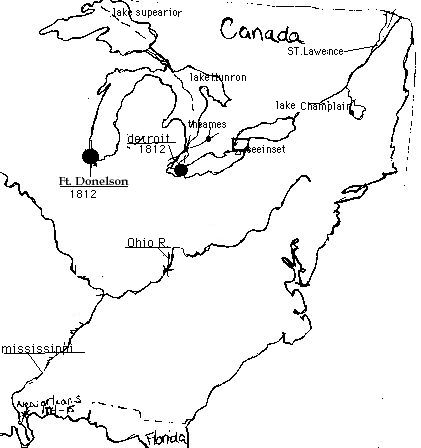
War of 1812

War of 1812
| Table of Contents | |
| Overview
Vocabulary Terms and Identifications |
Important
Maps
Biographies of Key Historical Figures |
|
|
|
The
conflict of the War of 1812 was that the U.S. was irritated by the vague
U.S.- Canadian boundary and the unfulfilled promise in the treaty of 1783
that said that Britain would remove its forts from unsettled areas of the
American Northwest. But the British wanted to keep control of the Indian
fur trade and maintain a buffer of Indian nations between the United States
and Canada, which would block the “land-hungry American settlers.”
Great Britain allied its
forces with Tecumseh, the chief of the Shawnee tribe, who wanted to unite
all of the tribes that were affected into a confederation to wage war against
the American frontiersmen. The British agents would supply the guns and
ammunition to the Indians, who would then attack and kill the American
settlers. The British and Indians were now the main targets for the United
States.
James Madison signed the congressional declaration of war on June 18,1812. The strategy for the United States was simple: annex Canada, which at the time was a British colony, rather than confront the Royal Navy, which was the worlds most powerful. The United States was suffering defeats in its attacks on Canada in 1812 and 1813 proving to the U.S. that they were a little overconfident in their assumption that the war was going to end quickly.
In 1814, Britain
sent reinforcements to Canada and committed more resources to the war,
attacking Washington D.C., and burning down the President’s house.
Over a short amount
of time, the Americans gained fighting skill and materiel, handed the British
defeats in Canada in 1814, ending British hopes for a quick victory.
A peace treaty
was negotiated in Ghent, Belgium, and signed on Christmas Eve in 1814,
ending the war at last.
Vocabulary
1) Nationalism - a strong feeling of pride
for one’s nation.
2) Star Spangled
Banner - national anthem of the United States. Written by Francis Scott
Key on September 13, 1814, on a British warship that bombed Ft. McHenry.
When the sun came up, he wrote a poem about the bombing and it later became
the national anthem.
3) Tecumseh dies
- Oct. 5, 1813, U.S. troops
meet a force that was combined of British and Indian troops at Thames River. The
battle ended in victory for the U.S. but was a disaster for the Indians
because the Shawnee chief, Tecumseh died.
4) Oliver Perry
Victory - Sept. 1813, Perry's Navy
destroyed a British fleet on Lake Erie.
5) British Strike
Back - Aug. 1814 British troops
decide to take war to American troops by marching on to Washington.

The War of 1812
Biographies
of Important People
| Francis Scott Key
Francis Scott Key was sent with John Skinner to ask for the freedom of Dr. Williams Beanes. They granted the request but under some terms. They would not be set free until after they attacked Baltimore. Because they did not trust that they would keep quiet about what they have seen. After the battle it was dark. He had made several poems and taken many notes. The three of them were set free and took a little boat to shore. After the black smoke had cleared they could see the flag waving proudly. The flag had inspired Francis to write. He had only had an envelope so he only took notes. But every thing that he put down was from his hart. Once they reached land Francis wrote everything thing that had came to him and didn't stop until he was completely done. When he was done he named it he Star-Spangled Banner. Francis Scott Key didn't know this then but The Star-Spangled Banner was sold for over $24,000 dollars. |
Oliver Perry
Oliver Perry was a man with a lot of military background. He was a great naval officer during the War of 1812. He had requested to command forces at Lake Erie and was granted his wish. At Lake Erie Perry challenged British troops, they didn't have supplies for a fight so they retreated from Lake Erie and the next morning they fought. British troops had to surrender. |
Multiple Choice: Circle one.
1. The Star Spangled
Banner was written by:
A. Dr. William Beanes B. Francis Scott Key C.
George Washington D. James Madison
2. The president
during the war was
A. George Washington,
B. Bill Clinton C. John Tyler D. James Madison
3. Who
was a great naval officer during the War of 1812:
A. Patrick Henry B. James Monroe
C. Dolly Madison D. Oliver Perry
4. What
lake did Oliver Perry command troops on at age 28?
A. Lake Winnepesakee B. Lake Heron C. Lake Erie
D . Lake Superior
5. Francis
Scott Key was sent with who to beg for Dr. Beanes’ freedom:
A. John Skinner B. General Ross C.
Al Gore D. Dolly Madison
True/False Write the correct answer.
1. __ The Star Spangled Banner was sold for $24,000.
2. __ The USA lost at Lake Erie in 1813.
3. __ Britain declared war on the United States of America.
4. __ The United States won the battle at Fort McHenry.
5. __ The
end of the war was in 1813.
Multiple Choice:
1) B Francis Scott Key
2) D James Madison
3) D Oliver Perry
4) C Lake Erie
5) A John Skinner
True/False:
1) True
2) False
3) False
4) True
5) False
Student authors:
George Cassutto's Cyberlearning
World
[Lesson Plan of the Day] [Cassutto Memorial] [About the Author] [Search] [Civics Lesson Plans]